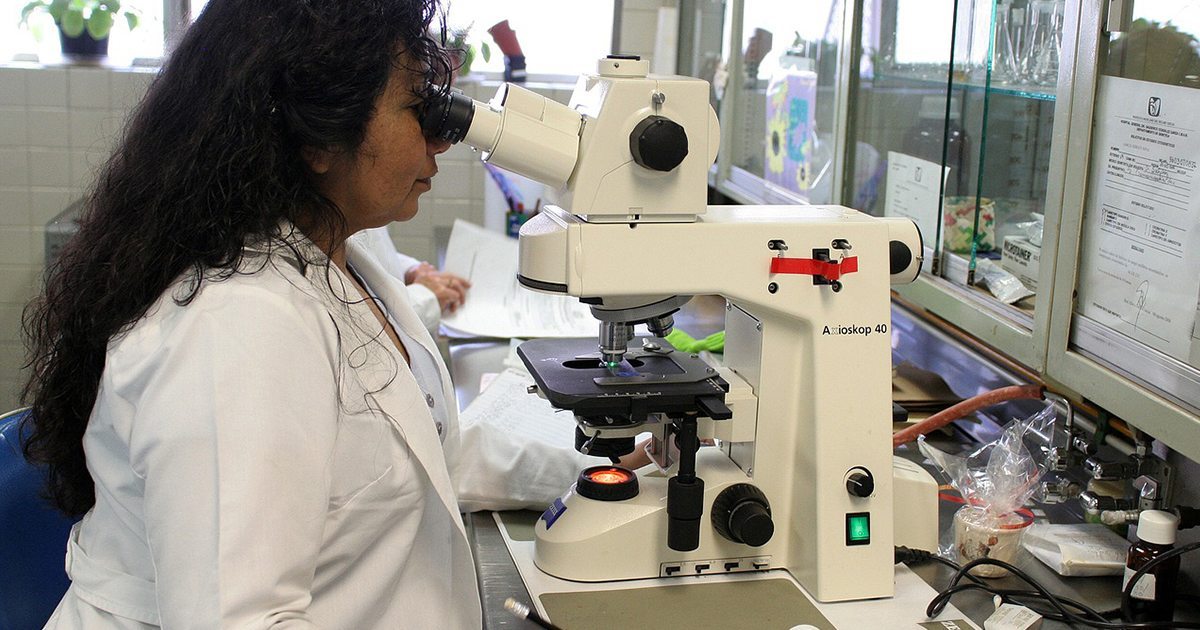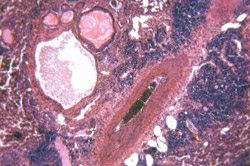Month: August 2011

Genetic Predisposition to Mesothelioma Observed by Cancer Researchers
By Wade Rawlins
People who carry a mutation in a certain gene are susceptible to developing mesothelioma and exposure to asbestos may significantly increase the risk of developing the life-threatening respiratory cancer, according to new research funded by the National Cancer Institute.
The study published in Nature Genetics reports on two American families with a high incidence of mesothelioma as well as other cancers associated with mutations of the BAP1 gene. It is the first study to demonstrate that family genetic makeup can influence susceptibility to mesothelioma, a cancer of the lining of the lung and abdomen. The discovery may lead to early detection and benefit people who have been exposed to asbestos in the workplace, people with a family history of mesothelioma and individuals who have previously been diagnosed with a rare tumor of the eye known as uveal melanoma.
Mesothelioma takes the lives of about 3,000 people a year in the U.S. The incidence of mesothelioma has risen steadily in the last decade in some parts of the world, including Europe and China. Yet, only a small portion of people exposed to asbestos or eronite, another mineral fiber similar to asbestos, develop symptoms of mesothelioma.
Scientists at the University of Hawaii Cancer Center in Honolulu and Fox Chase Cancer Center in Philadelphia followed two extended families with unusually high rates of mesothelioma for 14 years. The researchers suspected that mutations of the BAP1 gene, which is involved in tumor suppression, might underlie mesothelioma in people with a strong family history of the disease after noticing genetic changes in or near stretches of DNA where the BAP1 gene is located.
When the scientists looked more closely, they saw that every person who had provided a DNA sample and had developed mesothelioma or melanoma of the eye also carried mutations in the BAP1 gene.
The researchers then studied the genetic makeup of 26 patients diagnosed with mesothelioma who did not have a known family history of asbestos-related disease. They observed that tumors in about a fourth of the patients contained mutations in the BAP1 gene. In two cases, the mutations were inherited. Both of the individuals with inherited mutations had previously developed melanoma of the eye.
“The discovery is the first step in understanding the role of the BAP1 gene and its potential utility when screening for mutations in those at high risk,” said Michele Carbone, M.D., director of the University of Hawaii Cancer Center in a prepared statement. “Identifying people at greatest risk for developing mesothelioma, especially those exposed to dangerous levels of asbestos and eronite worldwide, is a task made easier by virtue of this discovery.”
People in jobs in which asbestos is an occupational hazard such as mining, shipbuilding, maintenance, plumbing and electrical work have a higher incidence of asbestos-related disease.
The study found evidence that some individuals with the BAP1 gene mutations also developed breast, ovarian, pancreatic and renal cancers, suggesting the gene mutation may be involved in multiple cancer types, also known as a cancer syndrome. About 10 percent of women with an inherited risk of breast or ovarian cancer carry mutations in the genes BRCA1 or BRCA2, which are associated with those diseases. Some inherited risk of breast or ovarian cancer may be associated with mutations in the BAP1 gene.
Just as breast cancer is linked to more than one gene mutation, Fox Chase scientists Joseph R. Testa, who led the study with Carbone, said that it appears likely that other genes in addition to BAP1 will be found to be linked with elevated risk of mesothelioma.

Cancer Survivorship Conference Gives Mesothelioma Patients and Their Families an Opportunity to Share Hope with Others
The University of Texas MD Anderson Cancer Center, ranked by US News & World Report as the nation’s best hospital for cancer care, is sponsoring their annual Anderson Network Cancer Survivorship Conference on September 16-17 at the Omni Westside in Houston, TX. The conference offers attendees an opportunity to share hope and gather support and understanding from other cancer survivors. Mesothelioma and cancer patients, their families and their caregivers are all invited to attend.
The MD Anderson Cancer Center has over 30 specialists on staff that supports their multi-disciplinary approach to treating mesothelioma patients. Their ongoing research and unique initiatives dedicated to finding a cure for mesothelioma, an asbestos-caused cancer of the lining of the lungs and abdomen, makes them one of the few cancer centers in the world with a comprehensive program. MD Anderson is also one of the leaders in focusing on personalized cancer treatment.
The National Cancer Institute defines cancer survivorship as covering “the physical, psychosocial, and economic issues of cancer, from diagnosis until the end of life.” Survivorship also focuses on the health and life of a person with cancer beyond the diagnosis and treatment phases. Survivorship includes issues related to the ability to get health care and follow-up treatment, late effects of treatment, second cancers, and quality of life. The conference offers sessions in many of these areas, and is open to anyone interested in cancer survivorship information.
This year’s conference features sessions with celebrity cancer survivors Dave Dravecky, Major League Baseball Pitcher, Barbara Padilla, First Runner-Up, America’s Got Talent, Sean Swarner, First Cancer Survivor to Climb Mt. Everest and Hans Rueffert, chef and author of “Eat Like There’s No Tomorrow.”
Conference sessions pertinent to mesothelioma patients and their caregivers include:
- Depression and Cancer: Real or Imagined?, Kathie Rickman, MD, DrPH, BSN
- Rough Road – Caregiver’s Struggle to Heal Their Own Physical and Mental Health, Guadalupe Palos, DrPH, LMSW
- Improving Outcomes with Comprehensive Lifestyle Changes, Lorenzo Cohen, PhD
- Cancer-Related Fatigue and Management Strategies, Ellen Manzullo, MD
The conference will also present some sessions in Spanish.
For more information or to register for the conference see the MD Anderson Cancer Center website.

Asbestos Ban Would Prevent Millions of Cancer Deaths
A University of Wisconsin epidemiologist says that the use of asbestos-containing building materials in developing countries will lead to millions of avoidable cases of cancer and an epidemic of asbestos-disease.
In an article in the September issue of the Annals of Epidemiology, Marty S. Kanarek, a University of Wisconsin School of Medicine and Public Health professor, said his review of health studies around the world suggests that an epidemic of mesothelioma, a cancer caused by asbestos exposure, is forthcoming in developing nations.
Mesothelioma is a cancer of the lining of the lung or abdomen caused by inhaling asbestos fibers. Most individuals who develop mesothelioma worked around asbestos and typically develop symptoms of asbestos disease 20 years to 50 years after exposure. In the United States, mesothelioma is blamed for 131,200 cancer deaths between 1985 and 2009 and 10 million worldwide. About 3,000 new cases of mesothelioma are diagnosed each year in the United States.
Kanarek, who has been studying the health effects of asbestos for 40 years, said his conclusion and that of many environmental health scientists is that all asbestos should be banned worldwide. “We could prevent a million or more cases of cancer,” Kanarek said in a press release issued by the University of Wisconsin School of Medicine and Public Health. “The evidence is very clear.”
Kanarek says the association between asbestos and serious respiratory health projects has been known for a century. But he contends that the asbestos industry has clouded the issue by attributing the health problems to a rarely used form of asbestos and not to chrysotile asbestos, which accounts for more then 95 percent of commercially used asbestos.
Kanarek reviewed dozens of studies of mesothelioma cases involving brake workers in the United States, miners in Africa, cement pipe factory workers in Egypt and concluded that chrysotile asbestos poses an occupational hazard of developing mesothelioma around the world.
“Because asbestos has not yet been banned in many countries, there are projections of an increasing epidemic worldwide,” Kanarek said. “Today, there are many safer, cheaper substitutes materials available, so the time is long past for a worldwide asbestos ban.”

Eleven Indicted in NY Asbestos Removal Project at Buffalo Housing Project
Three New York inspectors are among nine people and two companies indicted on criminal charges involving illegal asbestos removal at a Buffalo, N.Y. housing complex. Breathing asbestos causes life threatening diseases including mesothelioma and lung cancer so New York and federal laws strictly regulate the handling of asbestos-containing materials.
The 62-page federal indictment, handed down Aug. 4, focuses on work done by two companies that were hired to remove asbestos from the Kensington Heights housing project before its demolition. Johnson Contracting of WNY, Inc., was contracted to remove and dispose of an estimated 63,000 square feet of hazardous asbestos from each of six housing towers in the 17-acre complex. JMD Environmental Inc. was hired as a sub-contractor to monitor the asbestos removal work and do air sampling.
According to the U.S. Department of Justice release, from June 2009 to January 2010, workers for Johnson Contracting overseen by company president Ernest Johnson and supervisor Rai Johnson allegedly illegally stripped asbestos-containing materials at the Kensington Towers in violation of the Clean Air Act. The indictment accuses the company officials of instructing workers to dump asbestos-containing debris down holes cut in the floor and directing workers to leave asbestos in the towers knowing that the buildings were going to be demolished.
During the same time period, the JMD Environmental was supposed to monitor the asbestos removal work and perform air sampling, according to the Justice Department. The indictment alleges that JMD and its employees including supervisor Evan Harnden and three project monitors failed to conduct proper air sampling and created false visual inspection reports by certifying that all asbestos had been removed from the buildings.
Two city of Buffalo building inspectors also were charged with falsely certifying that all asbestos had been removed from the six buildings, when they knew the asbestos had not been removed. Also indicted was an inspector with the New York State Department of Labor Asbestos Control Bureau for allegedly concealing the illegal asbestos removal activities occurring at Kensington Heights.

Each of the 23 charges carries a maximum penalty of five years in prison, a fine of $250,000 or both.
Each year, an estimated 3,000 Americans are diagnosed with mesothelioma, a cancer of the lining of the lung that is a signature disease of asbestos exposure. Many older houses and buildings contain insulation, shingles and other building materials containing asbestos. Asbestos exposure is an occupational hazard for construction and demolition workers and a primary way people are exposed to asbestos today.

Free Mesothelioma Patient & Treatment Guide
We’d like to offer you our in-depth guide, “A Patient’s Guide to Mesothelioma,” absolutely free of charge.
It contains a wealth of information and resources to help you better understand the condition, choose (and afford) appropriate treatment, and exercise your legal right to compensation.
Download Now